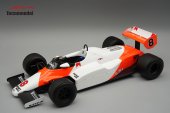ISSUE #29
Available August 2021
COVER STORY
Formula 1 season 1984
A strong line-up – Rules, teams and drivers of the 1984 grand prix season
Lauda and Prost open the gap – The first races of the 1984 season
Rain dance – Senna and Bellof aim for the top
Down to the wire – A world title decided by half a point
A strong line-up
Rules, teams and drivers of the 1984 grand prix season
Long before it started, there was promise that 1984 would be an exciting season of grand prix racing. In 1982 there had been 11 different winners from the 16 races. In 1983 there were seven different winners from the first eight races, and the season came down to a close battle between Nelson Piquet and Alain Prost, decided by two points. Ferrari drivers René Arnoux and Patrick Tambay hadn’t been far behind, the pair winning the constructors’ title for the Italians.
After missing out on the title for the third time, Prost was sacked by Renault and moved to McLaren, which had only finished fifth in ’83. That meant John Watson lost his place in Formula 1 after 11 seasons, although he was seen as a potential stand-in for a number of teams. Only Williams, ATS, Lotus and Arrows carried over their complete driver line-up. Ferrari showed interest in Keke Rosberg, who was keen to drive a turbo car, but the Finn stayed at Williams after the team inked a two-year deal to use Honda turbo engines. The Honda turbos had been tested by Spirit the previous season and were said to reach 800 horsepower in qualifying-boost trim. Ferrari improved its V6 turbo to 660 horsepower in race trim and was also working on a four-cylinder motor with better fuel economy. The Porsche turbo, which had debuted in mid-1983, produced 760 horsepower, and the BMW was worth at least 760 horsepower as well.
There were changes to the regulations, too. Fuel stops were banned, and fuel consumption was limited to 220 litres – which wouldn’t have been enough for any team over a race distance in 1983. Drivers had to learn how to manage boost pressure for the 1984 season, which Bosch simplified for McLaren with electronic control. In the press, there was talk about the first ‘remote-controlled world champion’, with journalists speculating that signals from the pit wall would determine the outcome of races.
Ken Tyrrell saw an opportunity for his team, given his naturally-aspirated cars enjoyed better fuel economy. Having protested the water injection systems used as additional engine cooling by Ferrari and Renault in 1983, Tyrrell now wanted to use his own version of the technology. It was supposed to help boost power (13 litres for 20 horsepower), but was seen by others as weight cheating. The Tyrrell was also unique in its shape while the other cars, unlike the previous year, all looked quite similar.
Formula 1 had big expansion plans for North America. In addition to the Canadian Grand Prix in Montreal and the ‘USA Central Grand Prix’ in Detroit, there were plans for races in Dallas (‘USA West’) and New York (‘USA East’). Long Beach had been dropped as the organisers were more interested in IndyCar. However, the New York event, which was meant to take place in Queens, didn’t go ahead. A planned new race in Fuengirola, Spain, was cancelled as well. To keep the schedule at 16 races, a Portuguese Grand Prix at Estoril was scheduled for late October…
by Jacob Queissner
Photographs: Motorsportimages, Cahier, McKlein
Rain dance
Senna and Bellof aim for the top
The 1984 Monaco Grand Prix was the sixth of the 16 races that season. By that point, it was hard to envision that someone outside of McLaren duo Alain Prost and Niki Lauda would become world champion. McLaren winning the constructors’ title was considered a foregone conclusion as well.
Before the race there was, once again, tension between the Automobile Club de Monaco and FISA regarding the TV rights. Those should have gone to the FIA, but the ACM had signed a contract with American network ABC. FISA threatened to revoke the event’s world championship status as tempers flared.
Several teams had legally been using balls in the tank to bring the volume down to the required 220 litres. McLaren, however, stopped using that method after it discovered that the plastic balls were absorbing fuel. Not all teams and engine manufacturers could master the limit of the tank volume. There were long faces at BMW as, so far, there had only been two finishes, zero points and a lot of broken engines. Marc Surer was supposed to drive the Arrows-BMW in Monaco, but he preferred the Cosworth-powered A6. ‘I knew it would be hard in qualifying – but on the plus side, the car would work in the race,’ said the Swiss driver. Meanwhile, Corrado Fabi drove his brother’s Brabham for the first time. Osella, Tyrrell, Ferrari and Renault all brought new chassis to the Principality. Renault didn’t plan on changing its carbon monocoque despite Warwick’s crash at Dijon.
Thursday: Lotus and Ferrari lead the way
Nigel Mansell was particularly motivated. Monaco was his favourite track, and his confidence was high after his third place at Dijon. He made good on that motivation by going fastest in the first practice session. Qualifying was a game of tyre poker. The Goodyears lasted just one lap, the Michelins three. But it was Alboreto who came out on top in Thursday qualifying in his Goodyear-shod Ferrari, running a hard tyre on the left rear…
by Jacob Queissner
Photographs: Motorsportimages, Cahier, McKlein
The Myth Is Born
Ferrari’s first victory in the Formula 1 World Championship
The success story of Enzo Ferrari, his cars and his famous racing team spans generations. In 2020 the Scuderia celebrated both 70 years since its first grand prix and its 1000th grand prix start. This summer there’s a new milestone to enjoy: 70 years since José Froilán González won Ferrari’s first world championship Formula 1 race at Silverstone on 14 July 1951.
The 1951 British Grand Prix marked a turning point in motor racing history. It was a race that saw Alfa Romeo, which had been the most successful manufacturer of the past three decades, hand its crown over to Ferrari. Many firmly believe it is a crown that Ferrari continues to hold to this day.
Fourteen months earlier, on 13 May 1950, the first round of the FIA’s new World Drivers’ Championship had been held at the same circuit. But there were no Ferraris in the field that weekend – so much for the claim that Ferrari competed in the Formula 1 World Championship from the very beginning. No official explanation was given for the Scuderia’s absence from that first race.
There’s a theory that Ferrari simply didn’t think its Formula 1 car was competitive enough at the time. The Tipo 125 had been built in 1948 and debuted at the Gran Premio d’Italia at the Circuito del Valentino in Turin on 5 September. Its supercharged 1.5-litre V12 was designed by Gioacchino Colombo and produced 225 horsepower. Raymond Sommer finished third behind Wimille’s Alfa Romeo and Villoresi’s Maserati.
The car was developed further for 1949 and fitted with a two-stage supercharger, which increased the power to 300 horsepower. After wins in the Dutch and Swiss Grands Prix, Alberto Ascari added another win at the Gran Premio d’Italia at Monza on 11 September. But despite those flashes of success, Enzo Ferrari was sceptical about the new world championship ahead of its debut season in 1950…
by Harold Schwarz
Photographs: Motorsportimages
French Affair
CD SP66
After years sitting idle, the 1966 CD Peugeot Le Mans, also known as the CD SP66, has been restored to its original glory and is back on track. The car was built in France, only raced on French circuits and was only driven by French drivers.
The CD SP66 featured here belongs to the Musée de l’Aventure Peugeot in Sochaux, in the east of France near the Swiss border. In poor condition, the car sat in storage there for years until somebody wanted to study it and it finally saw the light of day again. In 2016 the unrestored CD was awarded the World Motoring Heritage Year Preservation Award by the FIVA (Fédération Internationale des Véhicules Anciens).
Once the CD was out of storage, the decision was made to breathe fresh life into the car. Originally, a company based near the museum was meant to lead the restoration, but as it turned out, the price tag would have been too high. Moreover, the work wouldn’t have been finished in time for the 2018 Le Mans Classic. So, in November 2017, the museum approached restoration specialists Classic and Racing. They struck a deal in the December, and work started right away. The CD was restored over six months and 2,500 hours of work, in time for the Le Mans Classic in early July.
The chassis was basically in good condition, only the floor panel needed to be replaced. The tank was less straightforward. It sits between the engine and the cockpit in a sheet metal compartment, which has a single round opening (110 mm in diameter) for refuelling and venting. The challenge was getting the old bladder from 1966 out through the hole and then a new FIA tank bag back in.
Two other changes required by the FIA for a Le Mans start were the rain light and the roll cage. While a rain light could be fitted to the rear window without any problems, the cage wasn’t that easy. The flat CD’s narrow cockpit didn’t easily accommodate more bar work. But the car was 3D-scanned with the help of the Peugeot Design Department, and the data was used by Matter to build a custom cage.
The original motor had been tuned by Le Moteur Moderne in 1966, and the same company restored it again in 2019. The car had been entered for Le Mans in 2018 with Sylvain Ascension and Jean-Christophe Bolle-Reddat at the wheel, but was withdrawn after qualifying and the night session after suffering cooling problems in the hot weather. The engine and cooling system were then overhauled in 2019 and completed more running in 2020. Another Le Mans Classic campaign in 2022 is being considered…
by Jacob Queissner
Photographs: Motorsportimages, Classic and Racing
- Uwe Mahla about the Deutsche Rennsport-Meisterschaft
- Eckhard Schimpf about the first 6-Hour-race at the Nürburgring
- Jean-Marc Teissedre and Thomas Nehlert on Jean Rondeau
- Marco Werner and Ugo Vicenzi on the 12th Grand Prix de Monaco Historique
- Back on Track CD SP66
- and many more!
This product was added to our catalog on Saturday 10 July, 2021.




